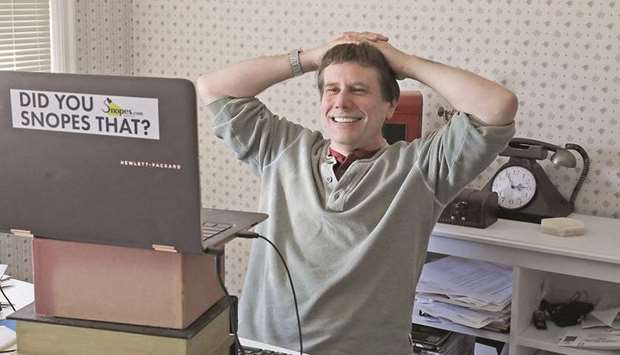In Tacoma, Washington, in a 97-year-old frame house in the city’s North End, is the headquarters of America’s most popular hoax-debunking website.
The command centre for Snopes.com is an upstairs bedroom with shelving and a laptop placed atop some books and a cardboard box.
These are busy times.
“Is This a Photograph of Christine Blasey Ford with Bill Clinton?” False.
“Did Protesters Vandalise Brett Kavanaugh’s House?” False.
“Is This a Photograph of a Wasted Brett Kavanaugh?” False.
“Is This a Photograph of Christine Blasey Ford Partying?” False.
All those viral hoaxes, spread by social media, have created a market for fact-checking sites, with Snopes, started in 1994, being the champ.
It gets 32 million visits a month on desktop and mobile, according to Similar.Web.com, an industry site that measures web traffic. Its closest competitors are The Straight Dope (4 million monthly visits) and FactCheck (3 million).
From his bedroom office, David Mikkelson, Snopes publisher and CEO, runs a site employing 16 people across the country, half of them fact-checkers and the rest on the business and web side.
The company could be run from anywhere with an Internet connection, but Mikkelson ended up in Tacoma in 2017 from California after he and his wife, Elyssa Young, bought her parents’ home.
Snopes found a market because the gatekeepers, the mainstream news organisations, went up against the Internet, he says.
“The Wall Street Journal. The Washington Post. Your crazy cousin’s blog. It all looks the same. A picture with a headline and subject. Before, they were relegated to a soap box on street corners or drafting a newsletter. Now anybody can throw up a website,” says Mikkelson.
Just recently, The Washington Post ran a story headlined “Beware the viral Facebook hoax that’s tricking people into thinking their account was hacked.” It cited Snopes to debunk the hoax.
It used to be that hoaxes tended to be more along the lines of, “Two teens making out in a car hear on the radio about an escaped killer with a hook for a hand. Returning home, they discover a bloody hook hanging from the passenger-side-door handle.” (False.)
They were called urban legends back then. Before the Internet, they spread as gossip between friends, maybe via supermarket publications focused on the sensational.
Mikkelson says that in Snopes’ early days, debunking such misinformation “was outside what standard news media were doing.”
So Snopes became a go-to site, and the more it was cited, the more popular it became. The origin of the name “Snopes” is that it’s a family of characters in the writings of William Faulkner.
Mikkelson’s wife at the time, Barbara Mikkelson, worked on the site, too. It was more of a hobby that eventually started making a little money from ads — “enough to take a weekend trip” — and then became a real moneymaker.
The marriage ended in divorce, with Barbara selling her share in 2016 to a company called Proper Media. There has been ongoing, messy litigation that was covered in-depth in Wired magazine last year.
In the Internet’s early days in the 1980s and ’90s, rumours began spreading through forwarded e-mails. Social media hadn’t yet arrived. Facebook wasn’t launched until 2004; Twitter until 2006.
Mikkelson, 58, says Snopes took off after September 11, 2001.
“Conspiracy theories were running rampant,” says Mikkelson. “We were the only ones cataloguing what was true or not. We had a huge spike in traffic.”
“Thousands of Israelis Were Absent from the WTC on 9/11?” False.
“Did Nostradamus Predict the 9/11 Attacks?” False.
After a while, the 9/11 conspiracy theories receded, but the urban legends remained. “A man turns to bid his unusual hitchhiker goodbye and discovers she has disappeared from the car. He later learns his mysterious passenger had died several years earlier.”
Then came 2008. Barack Obama ran for president.
“Everything went crazy,” says Mikkelson.
False: “Obama’s Kenyan Certified Registration of Birth.”
False: “Obama Admits He Is a Muslim.”
And it’s stayed political.
Certainly, President Donald Trump is known for such tweets as “Our Country’s biggest enemy is the Fake News so easily promulgated by fools!”
The mainstream media, meanwhile, have taken to fact-checking the president. The Washington Post runs an updated feature on false or misleading claims it says Trump has made since taking office. On Day 601, the tally was at 5,001.
Mikkelson says of himself, “I’m pretty apolitical. I’ve never run for office, never worked on a political campaign, never donated money to a political party or candidate, never so much as put up a campaign sign on my yard.”
His motivation is simple, he says. “This is my job.”
Snopes runs a continually updated Hot 50, and 47 of them have something to with politics. He chooses which “junk news” — Mikkelson’s preferred term — to research based on e-mails, postings on the Snopes Facebook group, and what content-tracking sites such as CrowdTangle and BuzzSumo report as trending.
He says he sees Snopes not so much as calling someone a liar, but as “mistaken, misinformed, misleading.”
The tools use by Snopes fact-checkers — many of whom have journalism backgrounds and are familiar with how to verify allegations — are pretty straightforward.
One recent bit of bogus tweets and postings involved Barbara Kinney, a Seattle-based photographer who was a staff photographer at the White House during Bill Clinton’s presidency, and who then travelled with Hillary Clinton during her two presidential bids.
On August 28, 2016, Kinney was walking directly behind Hillary Clinton as she left a fundraiser at a home in Southampton, New York. Associated Press photographer Andrew Harnik captured the image.
Fast-forward to the confirmation hearing of then-Supreme Court nominee Judge Brett Kavanaugh, when California psychology professor Christine Blasey Ford alleged Kavanaugh assaulted her.
Suddenly that 2016 photo went viral, usually with an arrow pointing to Kinney.
Typical was a tweet from a Stephen Whitt, who has 2,967 followers, and identifies himself as being from McRea, Georgia.
He proclaimed, “As suspected, Christine Ford’s lawyer Debra Katz is a Clinton/Soros associate. But of course. No agenda here except orchestrated ‘resistance.’ News you will never hear from the honourable media.”
Kinney and Katz both have short hair and their faces are similarly shaped, but it’d be hard to confuse the two.
Snopes was one of the fact-checking sites that called it out.
Kinney takes it in stride. “Yeah, I’ve gotten a little bit of a kick,” says Kinney, a former Seattle Times photo editor. She does wonder about a 2-year-old photo from a not particularly notable event. “Where do they find it?”
Helping the hoax go viral was the site TMZ, which later ran a one-sentence correction stating that someone had been “mistakenly identified” as Katz.
Someone like Stephen Whitt could have done the same thing a Snopes fact-checker does.
Run the photo through a Google reverse-image search site, which Snopes did in this case. That tells you where else on the web the image appeared, and it would show the original AP caption. In an e-mail, Kinney would indeed confirm it was her in the photo.
But what’s the fun in that?
Mikkelson says he doesn’t dwell on why so many people on Twitter just retweet an item that on the face of it, screams out that it’s dubious. Are there that many stupid people?
“I don’t like to use the word ‘stupid,’” he says. “You’re dealing with such a large audience on the Internet that even one-tenth of 1 percent of the population is several thousand people.”
Someone who has researched conspiracy thinkers is Joshua Hart, an associate professor of psychology at Union College in Schenectady, NY.
He lists “predictors” for belief in conspiracies:
— Suspiciousness and social anxiety.
— Odd or eccentric ideas, perceptions and behaviours.
— Belief that the world is a dangerous place.
— “Receptivity” to BS, “perceiving profundity in meaningless information.”
“You look at the world and see bad things happening,” Hart says about such individuals. “OK, someone might decide, ‘OK, reality sucks. Life’s unfair.’ On the other hand, you could say that there is this group of people working secretly to cause havoc. That might be preferable.”
At Snopes, the hoax reports just keep rolling in.
On a recent Friday, this nugget had reached the No. 1 spot on the Hot 50:
“Is Christine Blasey Ford ‘Deeply Tied’ to the Central Intelligence Agency?”
The question was asked by Michael Savage, the conservative-radio talk-show host, in his blog.
And the answer is: Just what is your receptivity to something that sure looks like it came from a bull? —The Seattle Times/TNS

BUSY BEE: David Mikkelson, founder of Snopes, the site that tracks fakery on the web, in his home office in a nearly 100-year old home in Tacoma, Washington.


